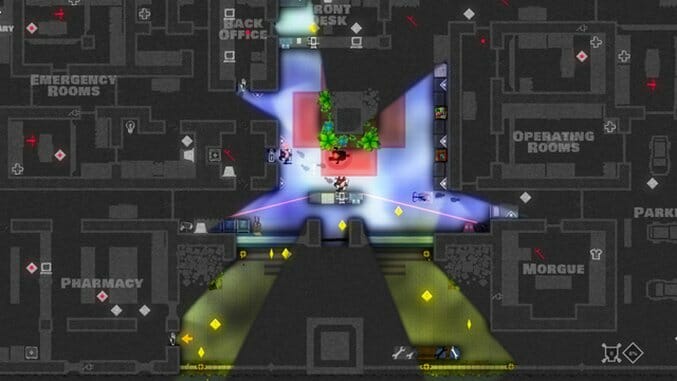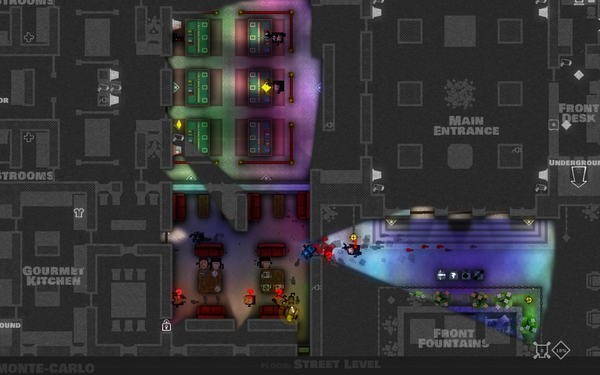
Monaco: What’s Yours Is Mine has journeyed long and far to get to where it is now. The game was developed by Pocketwatch Games and was the winner of the Grand Prize at the Independent Games Festival Awards (in a slightly different form) in 2010. After a long wait, here we are in 2013 with a heist game built for multiplayer. I’ll unpack that for you, because the concept of “heist game” paired with the qualifier “built for multiplayer” means a lot to me.
Monaco is a heist game. From a narrative perspective, this means that the game has taken every stereotype from every heist film you have ever seen and compiled them into one megaheist with an overriding throwback aesthetic. The game initially presents itself as a straightforward “recruit the members, pull the job” game, and you go through the motions of playing through the first twenty minutes of every Oceans Whatever film in mission format. When you’ve done a few missions, the game branches out and reveals its Rashomon conceit: Every character has a different version of the truth. You play through each version, each telling the story as filtered through the personality of the narrator, and I assume that you’re supposed to enjoy that.
I say “supposed” because it didn’t hook me in the slightest. The problem with collapsing a genre and then writing a game around the tropes is that you end up with a game that is solely tropes. Those tropes give us things like a pickpocket with a monkey companion, an older gentleman who can disguise himself, and a hacker who speaks in strange, garbled nonlanguage. They’re genre staples, and being genre staples, they’re sort of boring. Depending on these tropes also pushes Monaco toward being offensive—the heist genre, being based in the crime genre and descending from film noir, isn’t exactly equitable toward women. The Lookout, while invaluable to any setup, literally exists only to look, to observe, never to do; The Redhead, the femme fatale, can only seduce and charm. The women in Monaco only exist to look and be looked at, and that’s painfully sad.
Mechanically speaking, the game is a top-down affair, with the player navigating a 2D plane while attempting to reach a mission goal like “rescue x” or “steal y.” The map is almost totally obscured by a fog of war, but the game presents that fog of war as a blueprint—you are always aware of the shape of the map, but not the contours and contents of the rooms. Scattered around the map are guards, security cameras, proximity guns, and a number of other dangerous thing that have to be either circumvented or dealt with and disarmed. You do the work, you make it to the goal, you run out. Mission accomplished.
In other words, each map is a puzzle that each character navigates in her or his own way. An issue with this is that some characters are clearly at a disadvantage in certain maps, but the game doesn’t give you any warning about this. Trial and error becomes the name of the game. I don’t know about you, but I don’t have time to invest thirty minutes into a map only to find out that my character of choice is totally unfit to complete the mission. If only I had known before.
That was a thought that I had over and over during my time with Monaco. If only I had known that laser beams can be disabled by accessing them. If only I had known that guards can go into vents. If only I had known that The Cleaner can only put enemies to sleep when the enemies are unaware of his presence. I could go on like this for a while, but it wouldn’t change anything. There would still be more that the game springs on you, out of nowhere, wasting twenty minutes of your time because you didn’t know that setting off an alarm will sometimes double lock a door.
Monaco is a game that shines when the core mechanics are working. There’s something magical when the game presents itself as a puzzle and gives you all the pieces you need to solve it. Sadly, that condition is limited to the first few missions. After that point, I felt like I slogged through every mission and goal just to maybe unlock a new, cooler character who would maybe make the game more exciting. Then I unlocked the last character and I lost all hope.
Not all of this is Monaco’s fault. As I said before, Monaco is built for multiplayer, which I’m not a fan of, but the two or three hours I spent playing with other people were an alright time. The game’s proclivity to erupt into pure chaos makes for good sessions of yelling “go there!” and “run!” with friends. Still, it felt like Monaco was driving me out of the experience, and if I couldn’t stay motivated to stick it out through unpredictable stealth situations, is that wholly my fault?
If you are patient, if you like heist films, or if you have a strange attraction to blueprints and their navigation, Monaco is for you. It was not for me.
Monaco: What’s Yours Is Mine was developed by Pocketwatch Games. Our review is based on the PC version. It is also available for the Xbox 360.
Cameron Kunzelman blogs at thiscageisworms.com and tweets at @ckunzelman.
